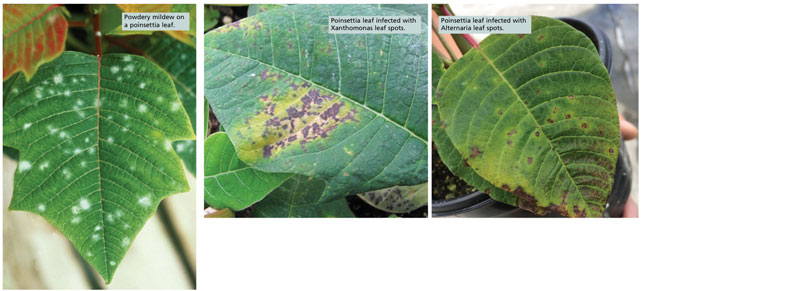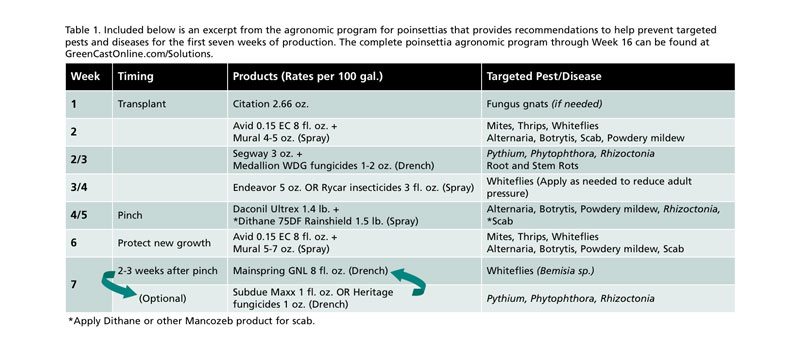5/1/2021
Stay in Control
Nancy Rechcigl
Spring production is in full swing with summer coming quickly on its heels. Poinsettia cuttings have been ordered, which means preparations for poinsettia production will begin soon. One of the most important aspects of poinsettia production is planning for effective disease control. Poinsettias are susceptible to many diseases, so taking preventive steps to protect your plants and stop the spread of harmful diseases is critical.
Before anything else, one of the best measures for prevention is greenhouse sanitation. Many pathogens can remain in the production area between crops, so providing a clean, dry growing environment and checking incoming plants for symptoms are two steps to help prevent disease.
 Pictured: Powdery mildew on a poinsettia leaf. • Poinsettia leaf infected with Xanthomonas leaf spots. • Poinsettia leaf infected with Alternaria leaf spots.
Pictured: Powdery mildew on a poinsettia leaf. • Poinsettia leaf infected with Xanthomonas leaf spots. • Poinsettia leaf infected with Alternaria leaf spots.
Step one: Proper disease identification
A wide range of ornamental diseases can affect poinsettias, requiring you to stay alert and closely monitor for potential symptoms. Knowing how and when to spot symptoms will assist you in implementing corrective actions sooner rather than later. The most common diseases you may encounter when growing poinsettias are:
Alternaria leaf spots
Alternaria leaf spots begin as small lesions with a tan center and dark margins. They’re semi-rounded and often surrounded by chlorosis, a yellowing of leaf tissue. As the infection spreads throughout the leaf, it’ll become more chlorotic and eventually drop from the plant. These spots can often be mistaken for bacterial leaf spot caused by Xanthomonas axonopodis.
Xanthomonas axonopodis
Infections by this bacterial pathogen cause small, angular-shaped spots with dark, brown margins. If you hold the leaf up towards the light, you may notice water-soaked or chlorotic tissue around the margin of the lesion. Keeping excess water off the foliage will help reduce the spread and severity of both fungal and bacterial leaf spot diseases.
Botrytis
Most common in cool, humid environments, Botrytis is especially problematic in the later stages of poinsettia production. Water-soaked, V-shaped lesions on the foliage and bracts form upon initial infection. Once established, the mold tends to quickly spread throughout the crop and production area.
Powdery mildew
Powdery mildew can be particularly problematic for poinsettias that are produced in cooler regions. First appearing as small, chlorotic spots on the foliage, these areas are eventually covered with white, fluffy colonies of fungus. Heavily infected leaves will turn yellow and drop from the plant. If left untreated, this pathogen will continue to spread throughout the plant canopy, reducing quality and sales.
Step two: Protect poinsettias with a proactive agronomic program
By planning ahead and mapping out an effective protection plan, you can ensure your poinsettia crop remains healthy. To stay ahead, you should follow a strict schedule, examine plants often for disease symptoms and have an effective fungicide program ready to handle any diseases that could infect the poinsettia crop during production.
Plant protection products are essential when environmental conditions are conducive to disease development or when symptoms are first observed. The frequency of applications should be based on the activity of the product, current environmental conditions, disease lifecycle and level of pressure. Additionally, it’s critical to proactively delay the development of resistance by rotating products with different modes of action.
To help manage difficult diseases, Syngenta has developed an agronomic program for poinsettia production that provides recommendations to prevent pests and diseases that can impact crop quality. The Syngenta poinsettia agronomic program includes Mural fungicide. It combines an advanced generation SDHI, SOLATENOL technology and Heritage fungicide, delivering superior systemic control.
In addition to Mural, the program offers a variety of control options and identifies the application timing where they’ll be most beneficial based on their strengths, modes of action and length of control. Since circumstances change depending on region, the program is designed to be a guide for growers.
The program:
• Offers a built-in resistance management strategy
• Reduces the need for corrective or curative actions
• Helps to ensure the production of a high-quality crop
Whether beginning from propagation or transplanting from liners, Syngenta’s agronomic programs are strategically developed to provide the best recommendations to control and prevent various insects and diseases that can negatively impact crop quality. GT

Nancy Rechcigl is technical services manager for ornamentals for Syngenta.